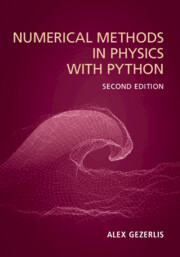8 - Differential Equations
Published online by Cambridge University Press: 30 August 2023
Summary
Chapter 8 starts out with a physics motivation, as well as a mathematical statement of the problems that will be tackled in later sections. Starting from differential-equation initial-value problems, the text introduces both explicit and implicit methods, like backward Euler and the fourth-order Runge-Kutta method. Emphasis is placed on the interplay between method stability and problem conditioning (stiffness). The chapter then discusses boundary-value problems, first, via a combination of the earlier machinery on initial-value problems along with root-finding techniques and, second, via a finite-difference/matrix approach, which converts the problem to a linear system of equations. Next, the chapter tackles eigenvalue problems, again, via either rootfinding plus earlier tools, or a finite-difference approach; this time, the latter turns into a matrix eigenvalue problem. The second edition discussesfinite-difference approaches to solving the diffusion equation. The chapter is rounded out by a physics project, on Poisson’s equation in two dimensions, and a problem set. The physics project introduces and uses the two-dimensional fast Fourier transform, as part of a spectral method applied to the solution of a partial differential equation.
Keywords
- Type
- Chapter
- Information
- Numerical Methods in Physics with Python , pp. 566 - 656Publisher: Cambridge University PressPrint publication year: 2023

